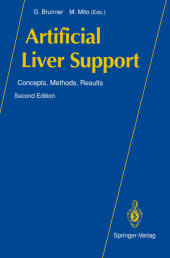 Neuerscheinungen 2011Stand: 2020-01-07 |
Schnellsuche
ISBN/Stichwort/Autor
|
Herderstraße 10
10625 Berlin
Tel.: 030 315 714 16
Fax 030 315 714 14
info@buchspektrum.de |

K. Akamatsu, H. Aoki, W. S. Arnaout, G. Backfisch, J. Bahlmann, S. Bengmark, P. D. Berk, G. Brunner, M. Mito
(Beteiligte)
Artificial Liver Support
Concepts, Methods, Results
Herausgegeben von Brunner, G.; Mito, M.; Mitarbeit: Akamatsu, K.; Aoki, H.; Arnaout, W. S.; Backfisch, G.; Bahlmann, J.; Bengmark, S.
2. Aufl. 2011. xvi, 450 S. 50 Tabellen. 235 mm
Verlag/Jahr: SPRINGER, BERLIN 2011
ISBN: 3-642-77361-3 (3642773613)
Neue ISBN: 978-3-642-77361-7 (9783642773617)
Preis und Lieferzeit: Bitte klicken
Continuing progress has been made since the first edition of Artificial Liver Support was published. Liver transplantation has however become an estab lished therapy for a relatively small number of patients who remain patients for life. There therefore continues to be a great need for the development of other forms of artificial liver support. Improved intensive care utilizing improved plasma exchange, dialysis, sclerotherapy, and intracranial pressure monitoring have improved survival in fulminant hepatic failure. Progress has also been made in lipid membrane detoxification, in cell cultures, and in cell transplantation, and the isolation of various liver cell growth factors has led to deep insight into the mechanisms of liver regeneration. This book gives the clinician and the researcher detailed information about established new methods of clinic work and laboratory research, and describes new experimental approaches indicating the direction of future research. G. BRUNNER M. Mno Preface to the First Edition The regenerative capacity of the liver cell is almost unlimited. Therefore after acute liver damage, be it viral, toxic, hypoxic, or surgical in origin, restitutio ad integrum is the usual outcome. In two forms of liver disease, however, this is not the case: in fulminant hepatic failure, liver regeneration often is not fast enough to keep the organism alive; in end-stage cirrhosis, regeneration is disturbed by a hypertrophic architecture of fibrotic tissue. For these extreme forms of liver disease and for critical situations before and after liver surgery, artificial liver support is needed.
I: General Aspects of Hepatic Failure.- Acute Liver Failure: History and Epidemiology.- Biochemistry of Liver Failure.- Mechanisms of Liver Cell Destruction.- Morphologic Aspects of Hepatic Regeneration.- Mechanisms of Regulation of Liver Regeneration.- Liver Regeneration: Molecular Mechanisms of Growth Control.- Animal Models of Hepatic Failure and Hepatic Encephalopathy.- Methods for the Assessment of Liver Function and Liver Regeneration.- Assessment of Liver Function in Donors by Use of the MEGX Test.- History of Artificial Liver Support.- II: Conservative Treatment.- Conservative Clinical Treatment of Acute Liver Failure.- Diagnosis and Therapy of Increased Intracranial Pressure and Brain Edema in Fulminant Hepatic Failure.- III: Hemoperfusion, Liver Perfusion, Dialysis, and Plasma Exchange.- Absorption Therapy in Acute Liver Failure: A Critical Resumé.- Selective Sorbent Hemoperfusion for Endotoxin.- Thermodynamic Criteria for the Removal of Certain Hepatic Insufficiency Markers from Protein-Containing Solutions.- Extracorporeal Hemoperfusion Over the Human and Baboon Liver.- Improved Methods of Extracorporeal Liver Perfusion for Temporary Replacement of Liver Function.- Pulmonary Microembolism Due to Plasma Exchange Replaced by Fresh Frozen Plasma.- Improved Plasma Exchange for the Treatment of Fulminant Hepatic Failure by Plasma Replacement into the Femoral Artery.- IV: Isolated and Immobilized Hepatocytes and Liver Tissue.- Cryopreserved Hepatocytes for Fluid Bed Reactors.- Artificial Cells for Artificial Liver Support.- Characteristics of Hepatocytes Immobilized Within Calcium Alginate and of a Bioreactor for Artificial Liver Support.- Immobilized Isolated Liver Cells on a Biomatrix.- Transplantation of Hepatocytes into the Spleen.- Problems and Controversies with Transplantation of Isolated Hepatocytes for Artificial Liver Support.- V: Enzymatic Liver Support and Lipophilic Hollow-Fiber Membranes.- Enzyme Preparation for Optimal Extracorporeal Enzymatic Detoxification.- Lipophilic Hollow Fiber Membranes for Enzymatic and Nonenzymatic Detoxification of Endogenous Lipophilic Toxins in Liver Disease.- Removal of Lipophilic Toxins from Blood by Matrix-Supported Lipid Materials.- Development of a Machine for Extracorporeal Removal of Lipophilic and Hydrophilic Toxins in Liver Failure.- VI: Surgical Support and Transplantation.- Can Resection of Cirrhotic Liver Stimulate Liver Regeneration?.- Intravasal Sclerotherapy of Esophagus and Fundic Varices as Therapy and Prophylaxis of Chronic Liver Failure.- Liver Transplantation Today: Indications and Results.- Hepatic Mitochondrial Redox Potential in Liver Transplantation and Artificial Liver Support.- Present Techniques and New Ideas for Liver Transplantation.


